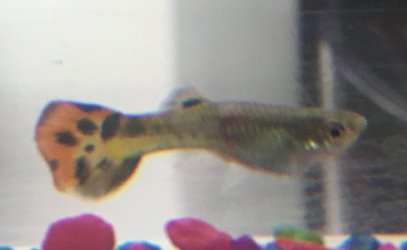BenjaminTX
New Member
My wife’s having trouble with her relatively new tank, today including a Guppy who’s developed a red spot, is not feeding, and is spending most of his time hovering near the surface of the tank. Pictures and details follow.
In spite of frequent water changes, ammonia hasn’t dropped below 1 (cycling the water with spring water testing at 0 before being added to the tank). A few other fish have been lost in the last few weeks with various symptoms, though perhaps many due to a Molly that was aggressive (and was returned to the store a week ago). Tank was treated with Kanamycin about three weeks after attempting to treat the last sick fish.
The Guppy has just been moved to a hospital tank (zero ammonia) with Kanamycin and receiving a separate salt water bath.
Thanks in advance for any and all help.
Tank size: 10 gallon
tank age: 1.5 months
pH: 7.4
ammonia: 1.5
nitrite: 0
nitrate: 5
kH: 40
gH: 75
tank temp: 80F
Fish Symptoms (include full description including lesion, color, location, fish behavior):
Red colored dorsal spot, not feeding, generally hovering near the surface of the tank. Previously some stringy poop. The red spot developed three days ago, the lack of feeding and activity began today.
Volume and Frequency of water changes:
Today (21 Feb) 20%, 14 Feb 30%, 5 Feb to 8 Feb daily water changes ~20%
Chemical Additives or Media in your tank:
Aqua Safe, Stress Zyme
Tank inhabitants:
No other guppies, one adult molly, two baby mollies
Recent additions to your tank (living or decoration):
none
Exposure to chemicals:
none
Digital photo (include if possible):

In spite of frequent water changes, ammonia hasn’t dropped below 1 (cycling the water with spring water testing at 0 before being added to the tank). A few other fish have been lost in the last few weeks with various symptoms, though perhaps many due to a Molly that was aggressive (and was returned to the store a week ago). Tank was treated with Kanamycin about three weeks after attempting to treat the last sick fish.
The Guppy has just been moved to a hospital tank (zero ammonia) with Kanamycin and receiving a separate salt water bath.
Thanks in advance for any and all help.
Tank size: 10 gallon
tank age: 1.5 months
pH: 7.4
ammonia: 1.5
nitrite: 0
nitrate: 5
kH: 40
gH: 75
tank temp: 80F
Fish Symptoms (include full description including lesion, color, location, fish behavior):
Red colored dorsal spot, not feeding, generally hovering near the surface of the tank. Previously some stringy poop. The red spot developed three days ago, the lack of feeding and activity began today.
Volume and Frequency of water changes:
Today (21 Feb) 20%, 14 Feb 30%, 5 Feb to 8 Feb daily water changes ~20%
Chemical Additives or Media in your tank:
Aqua Safe, Stress Zyme
Tank inhabitants:
No other guppies, one adult molly, two baby mollies
Recent additions to your tank (living or decoration):
none
Exposure to chemicals:
none
Digital photo (include if possible):



